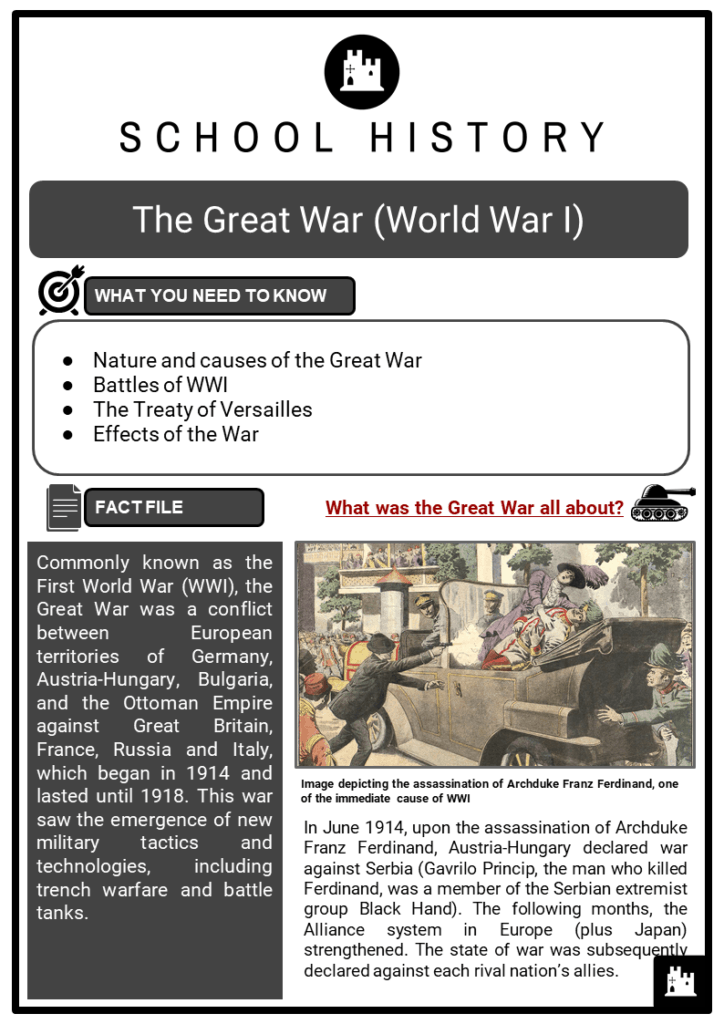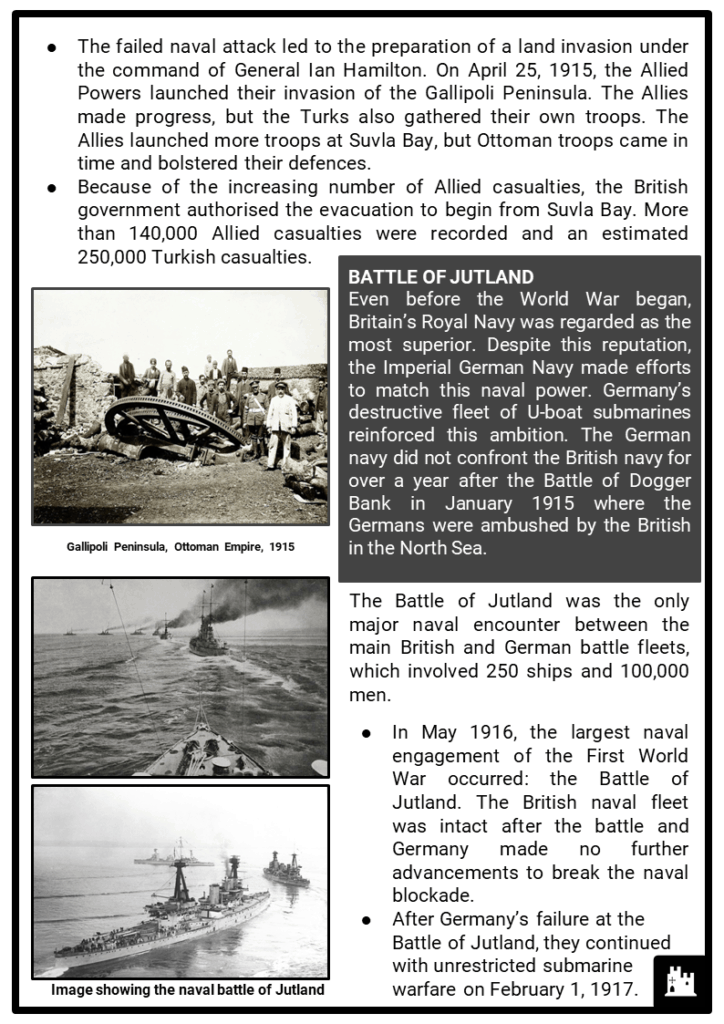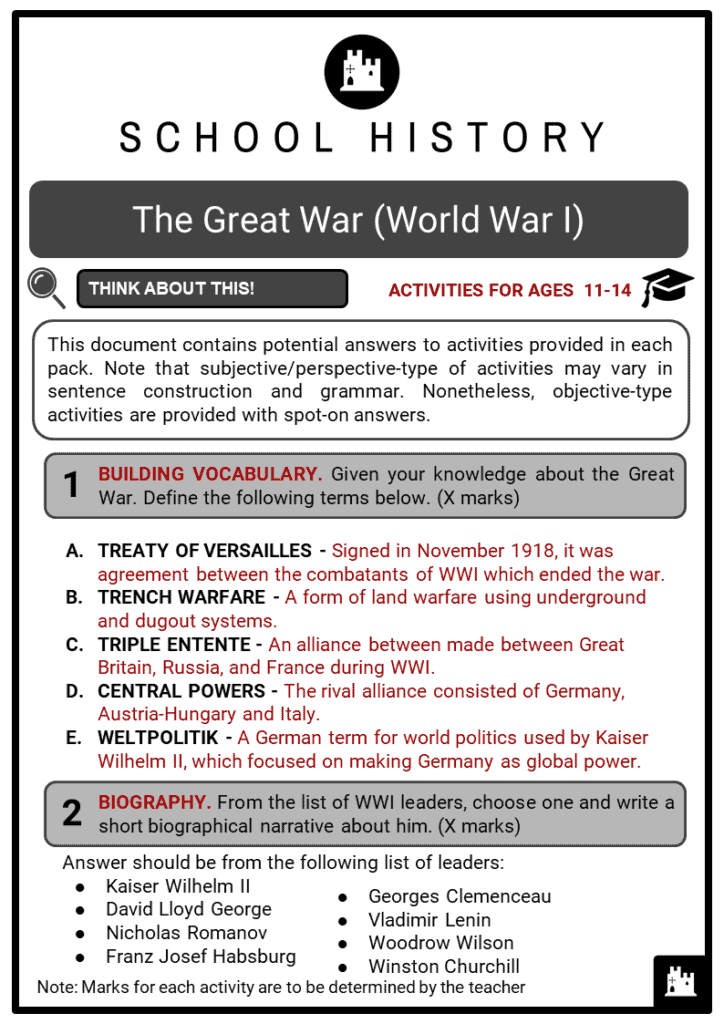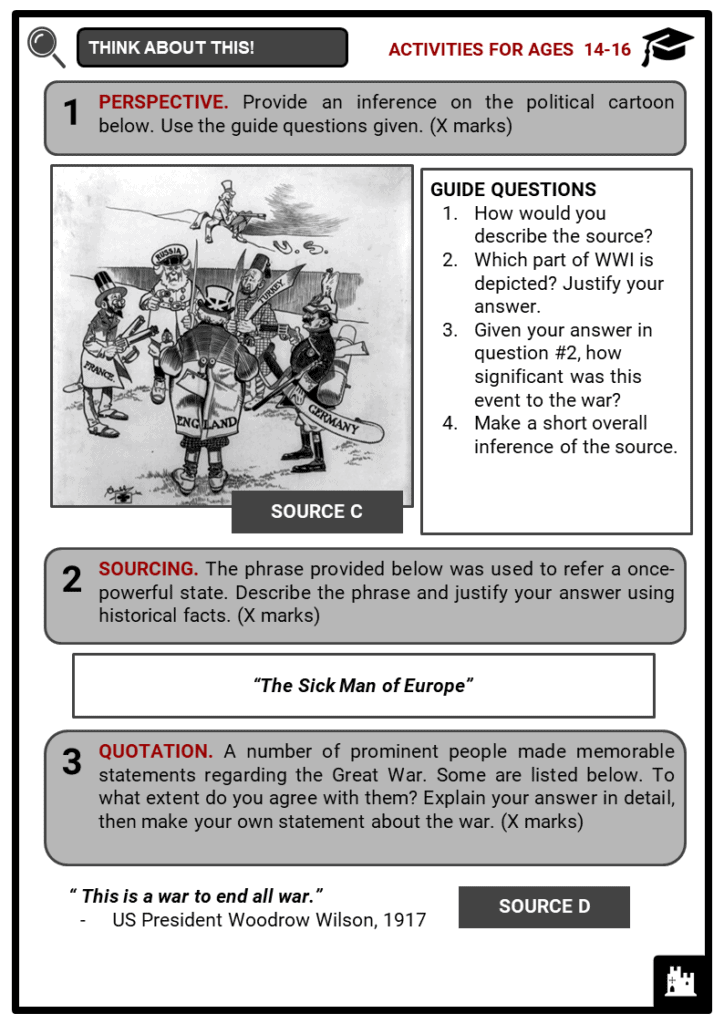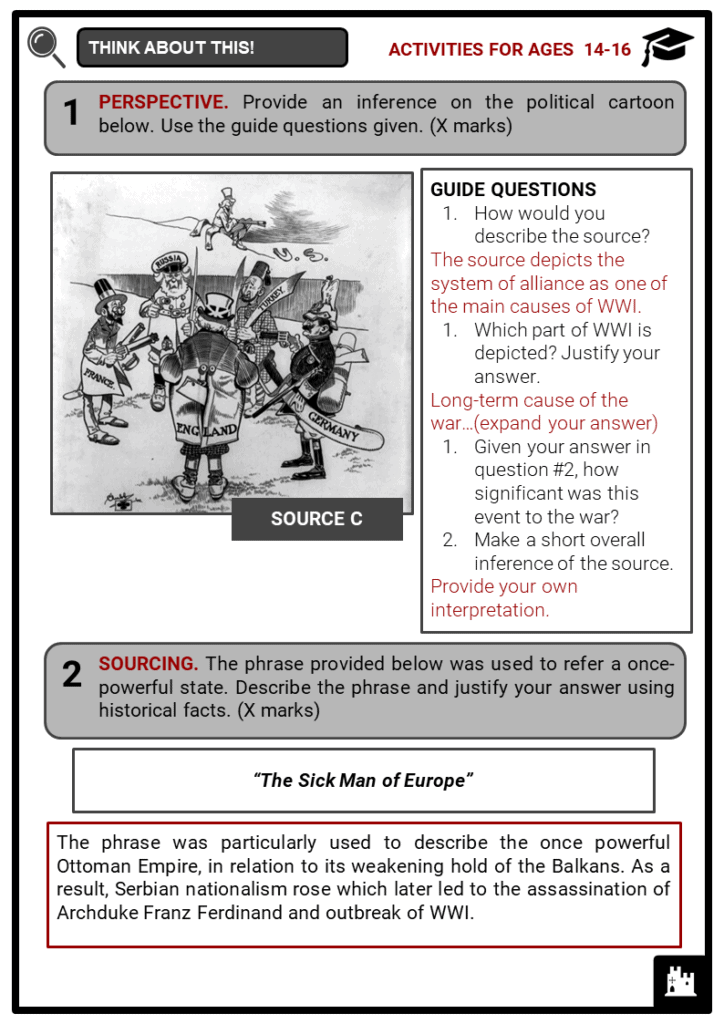Download The Great War (World War I) Worksheets
Do you want to save dozens of hours in time? Get your evenings and weekends back? Be able to teach The Great War (World War I) to your students?
Our worksheet bundle includes a fact file and printable worksheets and student activities. Perfect for both the classroom and homeschooling!
Table of Contents
Add a header to begin generating the table of contents
Summary
- Nature and causes of the Great War
- Battles of WWI
- The Treaty of Versailles
- Effects of the War
Key Facts And Information
What was the Great War all about?
- Commonly known as the First World War (WWI), the Great War was a conflict between European territories of Germany, Austria-Hungary, Bulgaria, and the Ottoman Empire against Great Britain, France, Russia and Italy, which began in 1914 and lasted until 1918. This war saw the emergence of new military tactics and technologies, including trench warfare and battle tanks.
- In June 1914, upon the assassination of Archduke Franz Ferdinand, Austria-Hungary declared war against Serbia (Gavrilo Princip, the man who killed Ferdinand, was a member of the Serbian extremist group Black Hand). The following months, the Alliance system in Europe (plus Japan) strengthened. The state of war was subsequently declared against each rival nation’s allies.
What were the long term causes of the war?
- The Alliance System
- One of the primary causes of the First World War was the formation of alliances. The purpose of an alliance is for countries to collaborate to achieve a common goal. Through alliances, countries are able to help each other and fill each other’s gaps and weaknesses.
- Countries that formed the CENTRAL POWERS.
- Germany
- Austria-Hungary
- Italy
- Countries that formed THE TRIPLE ENTENTE.
- France
- Britain
- Russia
- Countries that formed THE FRANCO-RUSSIAN ALLIANCE.
- France
- Russia
- GERMANY, being a newly united nation in 1871, sought to capture more territory, particularly part of Austria-Hungary. The way Germany planned to do that was to first help Austria-Hungary seize territory in the Balkans.
- ITALY, despite being a major enemy of Austria-Hungary in the past, recognised it had to join the Triple Alliance to achieve its own goal of setting up colonies in parts of Turkey, Greece, and the Balkan region.
Germany and Austria-Hungary, being two of the Central Powers at the time, formed a prior alliance in 1879 before Italy joined them in 1882. The three countries worried that France would launch an attack. In the event of an attack against any of them, they committed to assisting each other as allies. However, as individual countries, they had self-serving motives and goals they wanted to achieve from being part of the alliance. - AUSTRIA-HUNGARY was one of the most powerful nations in Europe. As a multinational state, it faced difficulties in consolidating the nations in its territory. To achieve its goal of conquering the Balkan territory, it had to ally with Germany.
- The alliance was periodically renewed until it officially lapsed in 1915 during the First World War. Italy entered the war as an enemy of Germany and Austria-Hungary.
- FRANCO-RUSSIAN ALLIANCE. Upon the expiration of the Reinsurance Treaty between Germany and Russia in 1890, France and Russia gradually grew close as nations, much to the dismay of the alliances formed by Germany. France and Russia had the common goal of opposing Germany and formed the Franco-Russian Alliance in 1894.
- ITALY’S SECRET ALLIANCE. While still part of the Triple Alliance, Italy made a secret agreement with France on November 1, 1902, guaranteeing their neutrality in the case of Germany attacking France.
- The renewal of the alliance in 1887 included Germany’s support of Italy’s plans to colonise the Balkan territory. Italy’s colonial ambitions were in conflict with Austria-Hungary’s because the latter nation also sought to possess territory in that region. Even with German Chancellor Otto von Bismarck intervening to pressure Austria-Hungary into settling Balkan land disputes with Italy, the two countries did not resolve their conflict of interest.
- TRIPLE ENTENTE, 1907
- On August 31, 1907, Great Britain, Russia, and France formed the Triple Entente, which then became the Allied Powers in the First World War. ‘Entente’ is French for ‘agreement.’ The Triple Entente developed mainly from:
The Franco-Russian Alliance of 1894;
The Anglo-French Entente Cordiale of 1904; and
The Anglo-Russian Convention of 1907. - THE ENTENTE CORDIALE.
Great Britain and France signed the Entente Cordiale not to be defence allies but to end their colonial rivalry and centuries of sporadic conflict. - THE ANGLO-RUSSIAN CONVENTION. To establish and respect their boundaries in Central Asia, Great Britain and Russia signed the Anglo-Russian Convention of 1907.
- Anglo-German Rivalry
- SPLENDID ISOLATION. Britain’s policy of “splendid isolation” was a diplomatic practice of avoiding fixed alliances with other Great Powers in Europe. This policy was upheld from the policy’s emergence in 1822 until its termination with Entente Cordiale in 1904 and its reversal during the Second Boer War from 1899 to 1902.
- Under the concept of Weltpolitik, Kaiser Wilhelm supported policies of colonisation through his decisions on:
- The Kruger telegram in 1896
- The Herero and Namaqua genocide beginning in 1904
- Suppression of the Maji Maji Rebellion in 1907
- First and Second Moroccan Crisis of 1905 and 1911.
- Naval Race
- Germany and Britain engaged in a naval race that lasted from 1898 to 1912. In 1897, German Admiral Alfred von Tirpitz planned to make a “fleet in being” to force Britain to give up its “splendid isolation.” At the time, Britain had the largest naval fleet in the world.
- In 1905, Tirpitz decided that the German fleet must rival the current building plan of the British. Despite much opposition, the Third Naval Law was passed in May 1906 because of the anti-British sentiment brought by the Algeciras Conference. British leadership continued to design plans to besiege the German coast.
- With Kaiser Wilhelm on board with the plan, five German Fleet Acts were passed in 1898, 1900, 1906, 1908, and 1912 to fund the construction of a German fleet two-thirds as big as the British Navy. The Second Boer War and the Boxer Rebellion secured passage of the Second Navy Law. Worry increased on the side of the British and so, in 1904, newly appointed Admiral John Fisher reorganised the Royal Navy and set out to revolutionise battleships by creating dreadnoughts.
- It was not until the passage of the Fourth Naval Law in 1908 that Britain began to be greatly alarmed by the buildup of Germany’s naval fleet and its anti-British stance, resulting in the British “Navy Scare” in 1909.
- The Anglo-German naval race had a lasting effect on relations between Britain and Germany. The race fostered distrust and hostility between the two nations, and it is widely accepted that the competition was a direct precursor of WWI.
- Pan-Slavism
- Pan-Slavists worked to drive forward a sense of unity and establish similarities among the Slavic people through the study of folklore and vernacular.
- Pan-Slavism was the political belief that the Slavic people of eastern and east-central Europe should have power over their own nations and the right to self-government.
- Pan-Slavists worked to drive forward a sense of unity and establish similarities among the Slavic people through the study of folklore and vernacular.
- Slavic people in the Balkan region had a significant role in the outbreak of WWI. Slav nationalism in Serbia grew to its strongest point in the late 19th and early 20th centuries.
- This national movement opposed Austro-Hungarian control. The annexation of Bosnia and Herzegovina caused the formation of radical nationalist groups, such as the secret Serbian society Black Hand, increased and they promoted the liberation of Serbia. The goal was to establish a unified state for all Slavic people called Greater Serbia.
Battles during WWI
- GALLIPOLI CAMPAIGN
- The Gallipoli Campaign was an operation by the Allied Powers against Turkey to control the sea route from Europe to Russia through the Dardanelles and to capture Constantinople.
- In 1915, the Allied Powers decided to launch naval ships into the Dardanelles Straits. The goal was to link up with the Russians so they could join forces against Turkey and force the latter to retreat. On March 18, 1915, 18 battleships of the Allies entered the Dardanelles Straits.
- The failed naval attack led to the preparation of a land invasion under the command of General Ian Hamilton. On April 25, 1915, the Allied Powers launched their invasion of the Gallipoli Peninsula. The Allies made progress, but the Turks also gathered their own troops. The Allies launched more troops at Suvla Bay, but Ottoman troops came in time and bolstered their defences.
- Because of the increasing number of Allied casualties, the British government authorised the evacuation to begin from Suvla Bay. More than 140,000 Allied casualties were recorded and an estimated 250,000 Turkish casualties.
- BATTLE OF JUTLAND
- Even before the World War began, Britain’s Royal Navy was regarded as the most superior. Despite this reputation, the Imperial German Navy made efforts to match this naval power. Germany’s destructive fleet of U-boat submarines reinforced this ambition. The German navy did not confront the British navy for over a year after the Battle of Dogger Bank in January 1915 where the Germans were ambushed by the British in the North Sea.
- The Battle of Jutland was the only major naval encounter between the main British and German battle fleets, which involved 250 ships and 100,000 men.
- In May 1916, the largest naval engagement of the First World War occurred: the Battle of Jutland. The British naval fleet was intact after the battle and Germany made no further advancements to break the naval blockade.
- After Germany’s failure at the Battle of Jutland, they continued with unrestricted submarine warfare on February 1, 1917.
- BATTLE OF VERDUN
- In order to secure German victory on the Western Front, Erich von Falkenhayn planned an attack in the ancient fortress city of Verdun, France. He aimed to dominate the surrounding area even before the Allies could consolidate power through the full deployment of the British forces.
- The Battle of Verdun took place from February 21 until December 15 1916, which became the longest battle in modern war history.
- Under Crown Prince Wilhelm, the German Fifth Army began the artillery bombardment. After five days, Fort Douaumont, the highest fort at Verdun, was captured. The French defence was led by General Philippe Petain who was known for his strategic line of defence. Petain was able to manage French troops and survived days of battle. In late April, General Robert Nivelle replaced Petain and began massive counter attacks.
- In response, the Germans renewed their offensive and took Fort Vaux by June, which became their last victory with increasing French resistance and arrival of reinforcements.
- BATTLE OF THE SOMME
- This encounter is considered as one of the largest battles of WWI. It’s also known as the Somme Offensive. The battle took place on July 1, 1916, near the Somme river in France, and the joint Franco-British campaign that took place against the Germans was considered one of the bloodiest military battles in war history. It was the first offensive campaign along the Western Front after two years of trench warfare with the Germans.
- The British forces, led by Gen. Douglas Haig and Gen. Douglas Rawlinson, started the attack from the northern region of the Somme, while the French troops came from the south.
- By August, the Allied naval forces had blocked both the North and Adriatic Seas, causing a food shortage in Germany. The German armies responded to the British tanks by deploying new planes in September.
- The Battle of the Somme gained a lot of criticism due to huge Allied casualties. It was known as the bloodiest military battle in history for incurring a total number of 420,000 British casualties, 200,000 French deaths, and nearly 500,000 German losses. Gen. Haig was also criticised for letting the campaign last until winter.
The Treaty of Versailles
- The Armistice of 11 November 1918 ended the conflict between the Allies and Germany, thereby ending WWI. It was prolonged three times until the Treaty of Versailles was signed on 28 June 1919 and took effect on 10 January 1920.
- Aside from the loss of territory, the Treaty of Versailles also stipulated control of the German military and abolition of the Air force.
Effects of the war
- Collapse of European Monarchies
- At the end of the war, the empires of Germany, Ottoman, Austria-Hungary, and Russia ended. In Russia, the Bolsheviks came into power, while fascism developed in Italy and later in Germany.
- Economic Balance
- Due to the high cost of the war, European countries were in deep debt. By contrast, the US became the highest industrial power and creditor in the world. The German economy saw its downfall as they needed to pay reparations to nations damaged by the war.
- Changing Role of Women
- With men joining the war, women replaced their positions in the workforce. Women then ran businesses and worked in factories. Moreover, labour laws and workers’ rights began to emerge along with the existence of mass production.
- Rise of Bolsheviks
- In December 1917, Russia signed an armistice with Germany wherein Russia surrendered Poland, Ukraine, and other regions. Moreover, Russians needed to pay 300 million roubles for the repatriation of prisoners. Russia’s poor war effort was also associated with weak organisation and command of Nicholas II. The tsar mobilised thousands of inadequate, unprepared, and ill-equipped troops. As a result of Russian defeat, the tsarist regime was blamed, which later on ignited the February Revolution. Tsar Nicholas II abdicated the throne, while the Bolsheviks led by Vladimir Lenin rose to power.
- Founding of the League of Nations
- After the war, superpower nations including Great Britain, the United States, and France founded the League of Nations. It was an international organisation established in 1919 that would promote peace and security among member nations.
- The Weimar Republic
- Wilhelm's power decreased steadily in wartime and, by 1916, the Empire had become a military dictatorship controlled by Field Marshal von Hindenburg and General Erich Ludendorff although Wilhelm still retained the ultimate authority.
- By 1918, support for the Kaiser had totally collapsed and an uprising in Belgium took him by surprise. The emergence of the German Revolution caused him to abdicate on 9 November 1918 when it became clear that only Friedrich Ebert, leader of the SPD, could effectively exert control over Germany. Wilhelm went into exile in the Netherlands. The end of WWI resulted in the replacement of the German federal constitutional monarchy with a democratic parliamentary republic that later became known as the Weimar Republic and the creation of the Weimar Constitution.
- New form of warfare
- Trench warfare was utilised on the Western Front from 1914 until the German Spring Offensive in 1918.
- The Western Front was the main theatre of conflict during the First World War. It encompassed a frontier built through France and Belgium.
- The Industrial Revolution and mass production systems paved the way for new military technology and tactics. Some of the most important tactics and technologies included trench warfare, poison gas, grenades, heavy artillery, and new weapons such as tanks and submarines.
- Trench warfare is a kind of land warfare where troops protect themselves from offensive firearm and artillery attacks through building huge trench, underground, and dugout systems. It became standard military practise by the beginning of the First World War. Soldiers would rotate in three positions: at the front line, in the support trenches, and at rest.
- The main trench system of three parallel lines joined by communications trenches was prevalent in the early stages of the war. Trenches were dug in a zigzag fashion. Later on, to prevent full exposure to the opponent’s fire if the enemy gained access at any point, the trenches were sectioned into fire bays linked by traverses.
- Three standard ways of digging a trench: Entrenching, Sapping and Tunnelling
- Weapons of WWI trench warfare:
- Infantry weapons, such as the rifle and hand grenade
- Barbed wire and razor wire
- Machine guns
- Artillery, such as infantry support guns and howitzers
- Landmines
- Mortars
- Helmets
- Poison gas and gas masks
- WHY USE TRENCH WARFARE?
- It was a key strategy to defend one's position while attempting to advance into the enemy's territory.
- It was at first an effective hindrance for attackers in fortified areas before it became a tactic for defence.
- Commonly, a trench was dug around twelve feet deep.
- Wooden beams and sandbags were used to fortify trenches.
- Duckboards were used on the floor of the trenches to keep soldiers and equipment out of the mud.
- All the trenches dug along the Western Front spanned a total of approximately 25,000 miles.
- The soldiers constantly worked at repairing the trenches after an enemy attack or erosion.
- At night, soldiers would stealthily cross No Man’s Land to raid the enemy.
- The conditions in the trenches were hard. Cold, rain and mud made it difficult for soldiers to move in battle.
- Soldiers would get sick and even die from the extreme cold and filth. Soldiers would develop an infection called Trench Foot from the moisture and mud. At times, trench foot could require a soldier’s foot or leg to be amputated. Minor wounds could quickly develop deadly infections.

